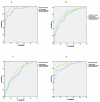Telephone-based identification of mild cognitive impairment and dementia in a multicultural cohort
- PMID: 21555635
- PMCID: PMC3102767
- DOI: 10.1001/archneurol.2011.88
Telephone-based identification of mild cognitive impairment and dementia in a multicultural cohort
Abstract
Background: Telephone-based interviews can be used for screening and to obtain key study outcomes when participants in longitudinal studies die or cannot be seen in person, but must be validated among ethnically and educationally diverse people.
Objective: To determine the accuracy of a telephone interview in classifying (1) demented from nondemented participants, (2) cognitively impaired participants from cognitively normal participants, and (3) participants with mild cognitive impairment (MCI) from those with normal cognition or (4) MCI from dementia among an ethnically and educationally diverse community-based sample.
Method: The sample consisted of 377 (30.5% non-Hispanic white, 34.7% non-Hispanic black, and 33.7% Caribbean Hispanic) older adults. The validation standard was diagnosis of dementia and MCI based on in-person evaluation. The Telephone Interview for Cognitive Status (TICS) and the Dementia Questionnaire (DQ) were administered within the same assessment wave.
Results: The sample included 256 people (67.9%) with normal cognition, 68 (18.0%) with MCI, and 53 (14.1%) with dementia. Validity of the TICS was comparable among non-Hispanic whites, non-Hispanic blacks, and Hispanics. Among non-Hispanic whites, the DQ had better discrimination of those with dementia from those without dementia and from those with MCI than among other racial/ethnic groups. Telephone measures discriminated best when used to differentiate demented from nondemented participants (88% sensitivity and 87% specificity for the TICS; 66% sensitivity and 89% specificity for DQ) and when used to differentiate cognitively normal participants from those with cognitive impairment (ie, MCI and dementia combined; 73% sensitivity and 77% specificity for the TICS; 49% sensitivity and 82% specificity for DQ). When demographics and prior memory test performance were used to calculate pretest probability, consideration of the telephone measures significantly improved diagnostic validity.
Conclusions: The TICS has high diagnostic validity for identification of dementia among ethnically diverse older adults, especially when supported by the DQ and prior visit data. However, telephone interview data were unable to reliably distinguish MCI from normal cognition.
Figures


References
-
- Brandt J, Spencer M, Folstein M. The telephone interview for cognitive status. Neuropsychiatry, Neuropsychology, and Behavioral Neurology. 1988;1:111–117.
-
- Desmond DW, Tatemichi TK, Hanzawa L. The Telephone Interview for Cognitive Status (TICS): Reliability and validity in a stroke sample. International Journal of Geriatric Psychiatry. 1994;9(10):803–807.
-
- Kawas C, et al. A validation study of the Dementia Questionnaire. Archives of Neurology. 1994;51:901–906. - PubMed
-
- Brandt J, Folstein MF. Telephone Interview for Cognitive Status, Professional Manual. Psychological Assessment Resources, Inc.; Odessa, FL: 2003.
-
- Gallo J, Breitner J. Alzheimer’s disease in the NAS-NRC Registry of aging twin veterans, IV. Performance characteristics of a two-stage telephone screening procedure for Alzheimer’s dementia. Psychol Med. 1995;25:1211–1219. - PubMed
Publication types
MeSH terms
Grants and funding
LinkOut - more resources
Full Text Sources
Medical

